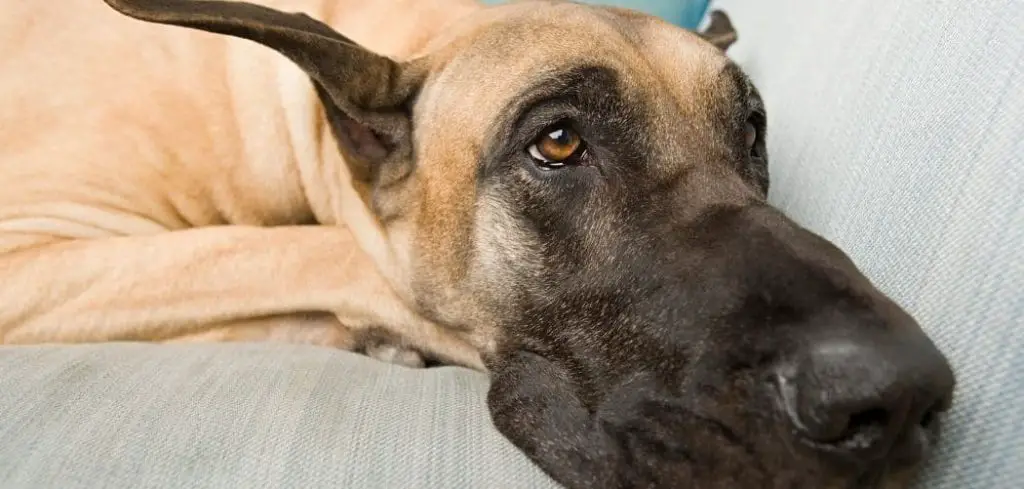When your dog has runny poop with blood and mucus, it can be a deeply concerning sight.
Loose stool is worrisome enough, but the presence of blood and slime-like mucus signals that something more serious may be affecting your dog’s digestive system.
We outline the common causes of runny dog poop with blood and mucus, what you can do at home, and when to seek veterinary help.
Runny Dog Poop with Blood and Mucus — Why It Happens
Runny dog poop with blood and mucus is often caused by irritation or inflammation in the digestive tract. Infections, parasites, dietary issues, and more severe conditions like colitis or hemorrhagic gastroenteritis can all trigger these symptoms. In some cases, stress, food sensitivities, or ingestion of harmful substances may also play a role.
Because the causes vary widely in severity, it’s important for pet owners to understand what might be happening.

Runny Dog Poop with Blood and Mucus: Common Causes
Parasites
Intestinal parasites such as hookworms, whipworms, and giardia are leading causes of diarrhea with blood and mucus in dogs.
These organisms attach to or irritate the intestinal lining, leading to inflammation, watery stool, and bleeding.
Puppies and senior dogs are especially vulnerable due to weaker immune defenses.
Owners may notice weight loss, poor appetite, or scooting along with the runny stool. Left untreated, parasitic infections can cause serious dehydration and anemia.
Read more: Smelly Watery Diarrhea in Dogs (What it means and what to do)
Dietary Indiscretion
Dogs are notorious for eating things they shouldn’t, from table scraps to spoiled food or even garbage.
When this happens, the digestive tract can become inflamed, leading to diarrhea with mucus and sometimes blood.
Even a sudden switch to a new food can upset your dog’s stomach. While some cases improve once the irritant passes, ongoing or severe diarrhea should always be evaluated by a vet to rule out something more serious.
Bacterial Infections
Bacteria such as Salmonella, Clostridium, or E. coli can infect a dog’s gut, producing runny, foul-smelling diarrhea with blood and mucus.
These infections are more likely in dogs who eat raw food, spoiled meat, or come into contact with contaminated surfaces.
Dogs may also develop fever, lethargy, and abdominal pain. Bacterial infections can become severe, especially in puppies, older dogs, or those with weakened immunity.
Colitis
Colitis refers to inflammation of the large intestine, which often causes mucus and streaks of blood in loose stool.
Stress, dietary intolerance, or immune-related conditions can all trigger colitis. Dogs with colitis may strain frequently, produce small amounts of runny stool, or seem restless after defecation.
While colitis can sometimes resolve with supportive care, chronic or severe cases require veterinary treatment.
Hemorrhagic Gastroenteritis (HGE)
Hemorrhagic gastroenteritis is a condition characterized by sudden, severe diarrhea that is often bloody and watery. While the exact cause isn’t always clear, it may be linked to bacteria, diet changes, or toxins.
Dogs with HGE often appear very ill, with vomiting, lethargy, and rapid dehydration. This is a life-threatening emergency requiring immediate veterinary attention.
Inflammatory Bowel Disease (IBD)
Some dogs develop long-term digestive inflammation known as inflammatory bowel disease.
This condition disrupts the normal absorption of nutrients and causes recurring diarrhea with mucus and blood.
Dogs with IBD may also lose weight, have a poor coat condition, and show changes in appetite. Managing IBD often requires special diets and medication, making veterinary guidance essential.
What to Do If Your Dog Has Runny Poop with Blood and Mucus
If your dog otherwise seems bright, active, and hydrated, you may be able to provide some short-term at-home support. Withhold food for 12 hours to give the gut a chance to rest, but always ensure fresh water is available to prevent dehydration.
After this short fast, reintroduce a bland diet of boiled chicken and rice in small portions. Watch closely for improvement within 24 hours.
If your dog recently got into the trash, ate something unusual, or experienced a stressful event, mild digestive upset may resolve with rest and diet adjustment.
However, if the diarrhea is persistent, worsening, or your dog shows additional signs such as vomiting or loss of appetite, do not delay professional help. Puppies, seniors, and small-breed dogs can dehydrate rapidly, so extra caution is needed.
When to Call or Visit Your Vet
Runny dog poop with blood and mucus should never be ignored if it persists beyond 24 hours or if your dog shows signs of distress. Seek immediate veterinary attention if you notice:
- Continuous watery diarrhea with large amounts of blood.
- Vomiting alongside diarrhea.
- Signs of dehydration such as sunken eyes, dry gums, or weakness.
- Refusal to eat or drink.
- Lethargy, collapse, or significant discomfort.
Your veterinarian may recommend stool tests, blood work, or imaging to determine the cause. Early intervention is key to preventing complications, especially in life-threatening conditions like hemorrhagic gastroenteritis.
Read more: Dog Diarrhea with Blood and Mucus (Understanding the causes)
Key Takeaway
Runny dog poop with blood and mucus is a clear sign that your dog’s digestive system is under stress. While mild cases may resolve with rest and supportive care, the presence of blood makes it more urgent to monitor closely.
If your dog appears unwell, is dehydrated, or the diarrhea continues beyond a day, veterinary attention is the safest step.
Your dog relies on you to notice the warning signs early. With prompt care and attention, many dogs recover fully, but timely intervention makes all the difference.
